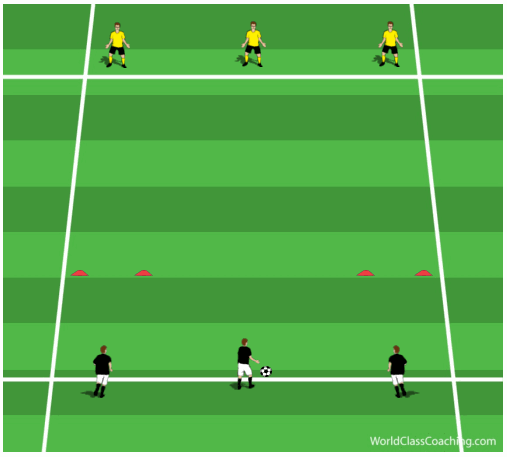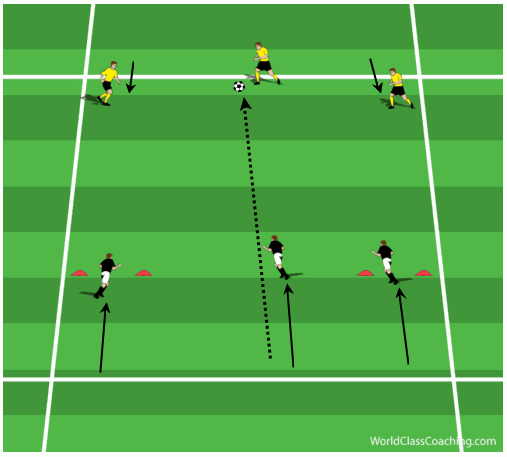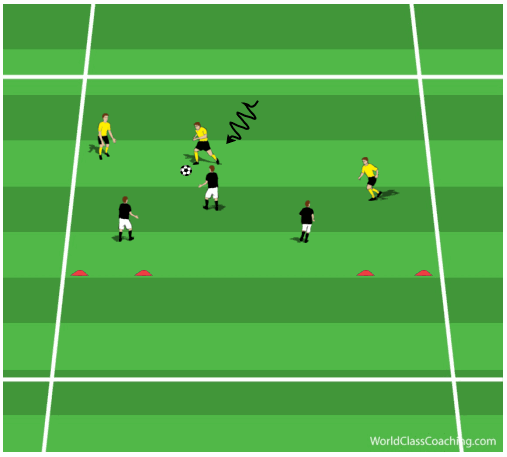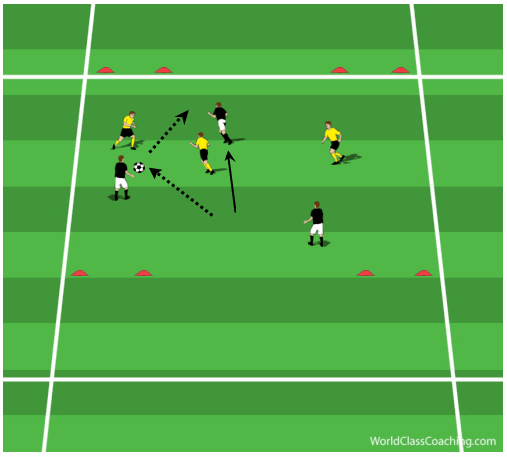By Justin Cresser
Playing a 3 v 3 small-sided game (SSG) is an excellent way to improve the anaerobic endurance of your players. It is also an excellent way to work on basic group defending and attacking. However, by making one simple modification you can get all the technical and tactical benefits of a normal 3 v 3 SSG and also target starting speed as well as acceleration. This exercise also places a greater emphasis on the anaerobic component.
Set up a 20 by 20 yard playing area. Place two small goals (1.5 yards apart) on the end line at the bottom of the playing area. Each goal should be 1 yard in from the closest sideline (Figure 1). Have 3 players stand a few yards apart, 10 yards behind the end line with the goals. These are your defenders. Have another 3 players stand a few yards apart on the end line at the top of the playing area. These are your attackers (Figure 1).

Play starts with one of the 3 defenders playing a hard pass along the ground to any of the 3 attackers. As soon as the ball is played (not before!), all 3 defenders sprint 10 yards and unto the playing area where they attempt to stop the 3 attackers from scoring or win possession. The attackers can enter the field and try to score once the player who receives the ball takes his first touch (Figure 2).

As soon as they enter the playing area, the attackers can try to score in any of the 2 small goals (Figure 3). There are no touch restrictions to start, although you can feel free to introduce a 2-touh restriction after a few repetitions.

Play stops if i) a goal is scored; ii) the defending wins the ball and keeps possession for at least 3 passes; or iii) after 45 seconds of continuous play. As soon as the play is finished, have both teams walk back to the initial starting positions (a rest period of about 90 seconds) and repeat the sequence. After 5 repetitions, have the 3 attackers and 3 defenders switch roles and perform another 5 repetitions.
You can progress this exercise by placing another pair of small goals on the end line where the attackers start. If the defenders win possession, they can attack and try and score in any of these two small goals (Figure 4).
- Before the ball is played, the defenders should be in a good ready position: low centre of gravity and body weight slightly forwards over the balls of the feet. When starting, the first step should be short, powerful, and in the intended direction.
- When accelerating the defenders should use short, powerful steps. They should also keep a low centre of gravity and lean forwards slightly
- Team shape from attackers (width and proper angles of support) and pressure, cover, balance from the defenders
- Good communication among the defenders is also important
By adding the sprint at the start, you also add an increased level of game awareness, as the 3 defenders have to quickly organize themselves and communicate once they have entered the playing area.
Justin Cresser - Has coached soccer at various levels both in North America and abroad (Hong Kong and Africa). His most recent position was as the Assistant Technical Director at the Soccer Club of Toronto. He has his National Diploma from the NSCAA and is also a certified strength and conditioning coach.



